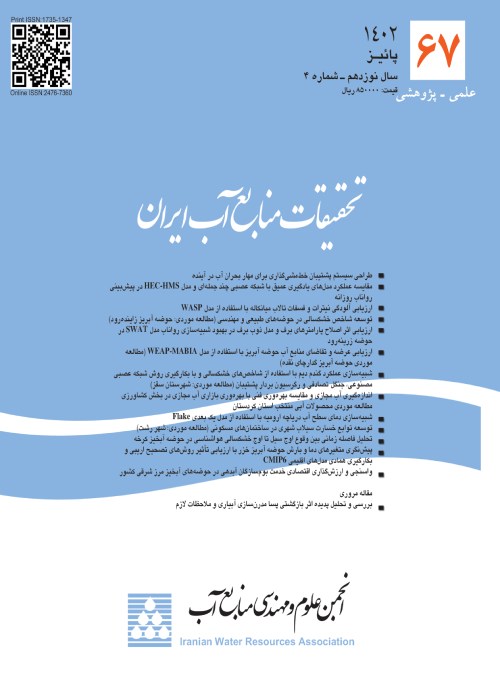Applying the Empirical Orthogonal Function (EOF) in Analyzing Precipitation Data
Author(s):
Article Type:
Research/Original Article (دارای رتبه معتبر)
Abstract:
Climate change in the past decade had serious impacts on food security and livelihoods in different parts of the world. EOF is one of the important methods for studying rainfall patterns in an area. The main objectives of the paper were to determine the best weight coefficients and frequency functions, determine homogeneous regions, model seasonal time series, and find the Severity-Area- Frequency (SAF), Duration-Area-Frequency (DAF), and Meteorological Drought Curves in three basins of Karun, Dez and Karkheh. In order to achieve the above objectives, 69 (Ministry of Energy’s) weather stations were selected in the research basins. After qualitative control, test and reconstruction of data, frequency functions and four weight factors (EOF) were obtained. Then, with the homogenization of the rainfall zone, the 291 cells in the ArcGIS9.3 environments were examined by ordinary kriging interpolation method. The results of the interpolation for first to forth weight functions (EOF) showed that the spherical semi covariogram with second degree of polonomial trend and unisotropy, the Gaussian no-trend with isotropy, the Gaussian with second degree of trend, and the spherical with second degree of trend and no-isotropy have the best distribution respectively. The homogenization of the region showed that the minimum average monthly precipitation in southern parts of Khuzestan Province and some eastern parts of Charmahal-o-Bakhtiari Province was 14.5-24.3 mm and maximum average monthly precipitation in northern parts of Khuzestan Province and south of Lorestan Province was 65.3-80.4 mm. Using the ARMA Stochastic Modeling Method with the SAMS program for each cell for 4 time series of frequency functions (PC), 12.000 rainfall data were obtained and then analysis of droughts was conducted. The results showed that the Gamma and Log-Normal statistical distribution for the return periods of 5, 10, 50, 100 and 200 years were the best fit for the series of relative shortages and drought persistence, respectively.
Keywords:
Language:
Persian
Published:
Iran Water Resources Research, Volume:17 Issue: 2, 2021
Pages:
31 to 48
magiran.com/p2333915
دانلود و مطالعه متن این مقاله با یکی از روشهای زیر امکان پذیر است:
اشتراک شخصی
با عضویت و پرداخت آنلاین حق اشتراک یکساله به مبلغ 1,390,000ريال میتوانید 70 عنوان مطلب دانلود کنید!
اشتراک سازمانی
به کتابخانه دانشگاه یا محل کار خود پیشنهاد کنید تا اشتراک سازمانی این پایگاه را برای دسترسی نامحدود همه کاربران به متن مطالب تهیه نمایند!
توجه!
- حق عضویت دریافتی صرف حمایت از نشریات عضو و نگهداری، تکمیل و توسعه مگیران میشود.
- پرداخت حق اشتراک و دانلود مقالات اجازه بازنشر آن در سایر رسانههای چاپی و دیجیتال را به کاربر نمیدهد.
In order to view content subscription is required
Personal subscription
Subscribe magiran.com for 70 € euros via PayPal and download 70 articles during a year.
Organization subscription
Please contact us to subscribe your university or library for unlimited access!


